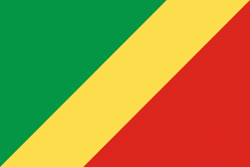Flag of the Republic of the Congo
The national flag of the Republic of the Congo (drapeau de la république du Congo) consists of a yellow diagonal band divided diagonally from the lower hoist-side corner, with a green upper triangle and red lower triangle. Adopted in 1959 to replace the French Tricolour, it was the flag of the Republic of the Congo until 1970, when the People's Republic of the Congo was established. The new regime changed the flag to a red field with the coat of arms of the People's Republic in the canton. This version was utilized until the regime collapsed in 1991. The new government promptly restored the original pre-1970 flag.
Under French colonial rule over French Congo, the authorities forbade the colony from utilizing its own distinctive colonial flag. This was because they were worried that this could increase nationalistic sentiment and lead to calls for independence. However, with the rise of the decolonization movement in Africa, the French were obliged to grant limited autonomy to the Congo as a self-governing republic within the French Community. This was granted on 28 November 1958, after a referendum was held and nine months later, the Legislative Assembly began deliberating over a national flag.
The new flag was officially adopted on 15 September 1959 and remained unchanged when the French Congo became an independent state less than a year later on 15 August 1960. It was hoisted on top of the building that formerly housed the French high commission to mark the proclamation of independence. In 1968, a coup d'état took place in the country, with the new government proclaiming the People's Republic of the Congo a year later. By doing so, it became the first Marxist–Leninist country in Africa. In order to symbolize the revolutionary change, the regime instituted a new national anthem and chose a new flag. This featured a red field charged with the country's new —a gold star with an overlapping hammer and hoe encircled by a wreath—in the top-left canton. The design was inspired by that of the Soviet Union's flag.
The red flag remained in place until 1991, when economic problems and the weakening of the Soviet Union's power due to the Revolutions of 1989 culminated in democratic elections and ultimately, the collapse of the People's Republic of the Congo. The National Conference, which oversaw the transition to a democratic government, reinstated the original flag from 1959 on 10 June 1991. The colours and shapes on the flag are mentioned in Article 5 of the constitution of the Republic of the Congo.
Under French colonial rule over French Congo, the authorities forbade the colony from utilizing its own distinctive colonial flag. This was because they were worried that this could increase nationalistic sentiment and lead to calls for independence. However, with the rise of the decolonization movement in Africa, the French were obliged to grant limited autonomy to the Congo as a self-governing republic within the French Community. This was granted on 28 November 1958, after a referendum was held and nine months later, the Legislative Assembly began deliberating over a national flag.
The new flag was officially adopted on 15 September 1959 and remained unchanged when the French Congo became an independent state less than a year later on 15 August 1960. It was hoisted on top of the building that formerly housed the French high commission to mark the proclamation of independence. In 1968, a coup d'état took place in the country, with the new government proclaiming the People's Republic of the Congo a year later. By doing so, it became the first Marxist–Leninist country in Africa. In order to symbolize the revolutionary change, the regime instituted a new national anthem and chose a new flag. This featured a red field charged with the country's new —a gold star with an overlapping hammer and hoe encircled by a wreath—in the top-left canton. The design was inspired by that of the Soviet Union's flag.
The red flag remained in place until 1991, when economic problems and the weakening of the Soviet Union's power due to the Revolutions of 1989 culminated in democratic elections and ultimately, the collapse of the People's Republic of the Congo. The National Conference, which oversaw the transition to a democratic government, reinstated the original flag from 1959 on 10 June 1991. The colours and shapes on the flag are mentioned in Article 5 of the constitution of the Republic of the Congo.
National flag
Country - Republic_of_the_Congo
Warning: getimagesize(/Image/Map/MP2260494.gif): failed to open stream: No such file or directory in /home/mapnlee7/public_html/MAPNALL/article.php on line 532
 |
 |
The region was dominated by Bantu-speaking tribes at least 3,000 years ago, who built trade links leading into the Congo River basin. Congo was formerly part of the French colony of Equatorial Africa. The Republic of the Congo was established on 28 November 1958 and gained independence from France in 1960. It was a Marxist–Leninist state from 1969 to 1992, under the name People's Republic of the Congo. The country has had multi-party elections since 1992, but a democratically elected government was ousted in the 1997 Republic of the Congo Civil War. President Denis Sassou Nguesso who first came to power in 1979 ruled until 1992 and then again from 1997 onwards.
